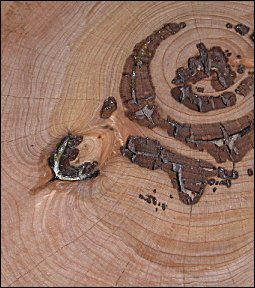
Did you know that you can tell time from a tree? Well, not seconds or minutes, but seasons and years. And sometimes, you can tell what the climate was during those times. In temperate climates, trees form rings, one per year. As they awake from winter's long hibernation, they have a spurt of growth, laying down large cells on the outside of last year's contribution. As the end of the season slowly approaches, however, newly created cells are smaller. The following year's production is clearly demarcated by the sudden appearance of large cells outside of these smaller cells.
Counting backwards from the time a tree has fallen or been cut, we can
easily travel into the past. By overlapping wood samples, we have a record going back
some 11,000 years. In stressed environments, climatic conditions often are reflected in
the width of rings. Dry years in the Southwest produce narrow rings; wet years, wide
rings. In some high elevation trees, temperatures are likewise recorded. Wood used in
prehistoric construction often can be dated and climate revealed by this science of
dendrochronology.
![]()
Contributor: Arthur H. Harris, Laboratory for Environmental Biology, Centennial Museum, University of Texas at El Paso.
Desert Diary is a joint production of the Centennial Museum and KTEP National Public Radio at the University of Texas at El Paso.

A partial cross section of an Arizona Cypress trunk with rings clearly visible. The trunk's center is toward the upper right; to the left and down, a cross section of a branch can be seen. The dark brown is tissue that has been attacked by bacteria or fungi and partially destroyed.
Fitts, H. C. 2001 [Reprint]. Tree rings and climate. Blackburn Press, Caldwell, NJ. [Reprint of a classic from 1976.]
Nash, S. E. 1999. Time, trees and prehistory: Tree-ring dating and the development of North American archaeology, 1914 to 1959. University of Utah Press, Salt Lake City, 294 pages.